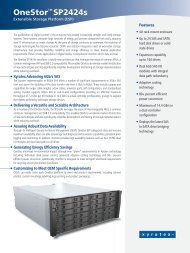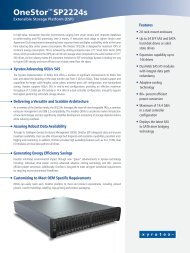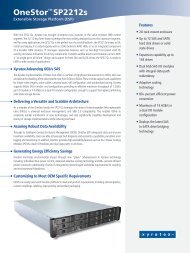Xyratex ClusterStorTM
Xyratex ClusterStorTM
Xyratex ClusterStorTM
Create successful ePaper yourself
Turn your PDF publications into a flip-book with our unique Google optimized e-Paper software.
6<br />
• Management Server (MGS) - The MGS stores configuration information for all Lustre file systems in a<br />
cluster. Each Lustre server contacts the MGS to provide information. Each Lustre client contacts the MGS to<br />
retrieve information.<br />
• Metadata Server (MDS) - The MDS (typically co-located with the MGS) makes metadata available to Lustre<br />
clients from the Metadata Target (MDT). The MDT stores file system metadata (filenames, directories,<br />
permissions, and file layouts) on disk and manages the namespace. The MDS provides network request<br />
handling for the file system.<br />
• Object Storage Server (OSS) - The OSS provides file I/O service and network request handling for one or<br />
more local Object Storage Targets (OSTs). The OST stores data (files or chunks of files) on a single LUN (disk<br />
drive or an array of disk drives).<br />
• Lustre Clients - Although not part of the integrated ClusterStor solution, Lustre clients are computational,<br />
visualization, or desktop nodes that mount and use the Lustre file system. Lustre clients see a single, coherent<br />
namespace at all times. Multiple clients can simultaneously read and write to different parts of the same file,<br />
distributed across multiple OSTs, maximizing the collective bandwidth of network and storage components.<br />
Overcoming Lustre’s Challenges<br />
Despite the obvious advantages of using Lustre as a backend file system in HPC deployments, legacy installations have<br />
shown limitations and challenges to users. Integrating Lustre into an HPC solution that overcomes these challenges<br />
drove the development and design of the ClusterStor family of integrated HPC data storage solutions.<br />
Installation and Administration<br />
Lustre is traditionally installed and administered strictly from a command-line interface, requiring fairly advanced<br />
knowledge of Linux administration and experience provisioning clusters and managing distributed nodes.<br />
System administrators may lack this knowledge or not understand the complexities of the Lustre software,<br />
requiring them to rely heavily on professional services and external support to deploy and administer the file<br />
system. Additionally, integrating Lustre into a storage system with heterogeneous hardware adds system and<br />
support complexity. It can take weeks to get the system up and running reliably, with additional effort required<br />
to tune system performance.<br />
ClusterStor Advantage:<br />
ClusterStor systems come installed and configured from the factory, fully optimized to work with Lustre, and<br />
ready to deploy right from the loading dock. This innovative HPC storage design leaves behind the complexities<br />
of other systems that integrate third-party equipment and require tuning of file system performance in<br />
a heterogeneous, multi-vendor infrastructure.










